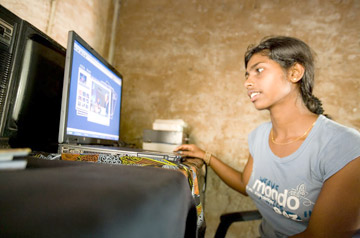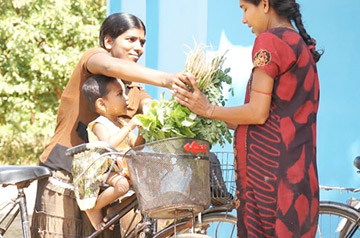Divi Neguma, the road map to MDGs
By Dhaneshi Yatawara
Globally sustainable development is the key word in achieving the
Millennium Development Goals ( MDGs). The world will focus on post MDGs
from 2015. Sri Lanka will also focus on meeting the demand of the post
MDGs.
|

Information Technology to boost quality of life |
Therefore, balancing the three pillars of the sustainable development
environmental, social and economical aspects need to looked into.
The Divi Neguma livelihood development program launched under the
directive of President Mahinda Rajapaksa is paving the waz to achieve
the MDGs in a sustainable manner.
Initiated under the Economic Development Ministry the Divi Neguma
program has come under a separate unit - the Department of Divi Neguma
Development.
Sustainable Development meets the needs of the present without
compromising the ability of future generations to meet their own needs.
Rather than importing the Western concepts of development the
government strategy formulated under the Mahinda Chinthana vision
focuses on the village - the smallest unit of the country's civil
administration.
The rural community will be the manufacturer of goods in a continuous
supply chain to the urban consumer. The Government initiated projects
such as the Divi Neguma, Gama Neguma, coordinated through the Economic
Development Ministry, aims at catering to this crucial manufacturing
rural community by uplifting them economically and socially.During the
past few years the contribution from regions outside the Western
Province has increased dramatically marking a significant change in its
contribution to national economy. The regional economy should be well
connected to the national economy.
Many development initiatives the Government provide various
infrastructure for regional development to link the village economy to
the national economy. The responsibility is to try and get the best
benefit of the regional development and link it with the national
economy.
Today the Divi Neguma program is a major contributor in developing
the rural economy.
In the Divi Neguma program the development proposals come from the
grass roots level.
Initially when the plans were afoot for the project Economic
Development Minister Basil Rajapaksa visited all 25 districts and in the
presence of the District Coordinating Committees these development
proposals were handed over to the political authority of that area to be
implemented.
Village level organisations such as the Janasabha, forward their
development program proposals.
The Grama Niladhari, Samurdhi officer of the village, work along with
these leaders of the Jana Sabha. Understanding the importance of the
village unit, President Mahinda Rajapaksa taking over Presidency for the
first time in 2005, instructed the Government to initiate a special
program to uplift village communities.
Thus, the Gama Neguma (Village uplift) was launched in 2006 on par
with the Mahinda Chinthana.
These projects also improved the capacity of the regions to link with
the mainstream of development.
These have a catalytic role in boosting commercial activities in the
villages thus making those communities a major contributor to national
economy.
|

Sharing the harvest |
The new approach of the Gama Neguma will strengthen the community
participation in the rural development projects by pooling resources to
be utilised for village development.Gama Neguma was launched in 119
backward villages and extended to 4,000 GN Divisions in 2007.
In 2008 and 2009 it was implemented with the exception of North and
East and from 2010 the peaceful environment in the country enabled the
implementation of the program throughout the island.
The village level organisations are responsible to implement the
programs.
Planning and implementation is by the villagers and funds will be
sent to the Divisional Secretaries and the village organisation will get
the funds for the program through the DS office.
Moreover, the road network development reduced the hassle of
travelling. On the whole it has enhanced the connectivity by exposure to
a broader arena bringing about positive changes and modifications in the
socio-economic fabric.
Farmers are highly benefited by facilitating the transportation of
the agricultural inputs and products with extended market options
promoting their turnover.According to the Mahinda Chinthana, "To win the
world, develop the country, to develop the country strengthen the
village." We as a country aim at doubling the Gross Domestic Product
(GDP) by 2016.
Thus it is important to get the maximum contribution to the national
economy through the more back-ward regions and promote regional
development to encourage equitable distribution of goods and services.
|

